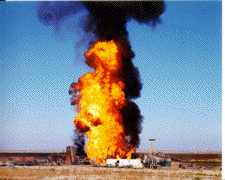Gary Whitlow brings new technology to the gas field
Sandia-developed geothermal drilling technology played a key role earlier this year in helping "kill" a wildcat natural gas well in California that blew out and remained out of control for six months.
On Nov. 23, 1998, the well, located in the Lost Hills Field, an area some 45 miles northwest of Bakersfield, Calif., ignited when natural gas escaped uncontrolled from the shattered well casing. Flames billowed more than 200 feet high, destroying the rig. The well burned uncontrollably for two weeks and then gushed large volumes of natural gas, salt water, and some oil. The water, spewing from underground, doused the fire, but natural gas continued to flow out of the well at a rate of about 17 million cubic feet per day, which was burned off in a flare.

Download 150dpi JPEG image, ‘fire_pix.jpg’, 1 Mb
As all attempts above ground to cap the well failed, a relief well, designed to intercept the first well’s bore, was started about a quarter- mile away. At a depth of about 16,000 feet engineers planned to pump cement through the relief well into the failed well to plug it and stop the continuous flow of natural gas. Concerned that the same conditions that led to the blowout in the first well were likely with the second, engineers and drill operators wanted a way to quickly detect gas kicks that could lead to another accident. (A kick is an influx of gas in an oil or gas well or steam in a geothermal well.) In steps Sandia "The drilling company was aware of a device we developed at Sandia, called a rolling float meter, that monitors drilling fluid returns to rapidly detect loss of circulation during geothermal drilling," says Gary Whitlow (6211), the Sandian selected to help out with the crisis. "They wanted to use the rolling float meter to detect gas kicks while drilling the relief well. "I was excited because, while we had used the device briefly on a controlled gas well drilling operation in Texas, we had never tried it on a well where we expected kicks and control of the well was so critical." The request for help came from the drilling company on a Friday in mid-January. Gary got his gear together over the weekend and then on Monday was off to California to oversee installation and calibration of the rolling float meter. Cement was pumped into the well on May 26, and the failed well was finally killed. Simple design
George Staller (6211), one of the rolling float meter developers, says the device has a simple design. The technology was introduced in the 1920s for measuring water flow in open irrigation ditches. Sandia began research and development on the rolling float meter in 1989, adding modern electronics and computers and making it rugged enough to be used on a drill rig.
Although Sandia developed it for geothermal drilling to detect lost circulation and steam kicks, it works just as well in oil and gas drilling.
In drilling, a continuous flow of mud is circulated from the surface through the drill pipe and drill bit then back to the surface through the annulus between the well bore and drill pipe. This is done to eliminate rocks and cuttings produced during the drilling process.
The mailbox-size rolling float meter, which consists of a wheel that rides on the surface of the fluid, is mounted on top of the rig’s outflow pipe. It measures the flow rate of drilling fluids leaving the well. When a kick is present, the velocity of the mudflow increases and the rolling float meter measures a sudden increase in outflow.
Having this flow information lets drill operators know exactly what’s coming out of the well, giving them time to increase the weight of the mud so it will be heavy enough to keep the gas or oil from flowing into the well bore but not so heavy as to go into the rock formation itself. Overweight mud can damage the formation, while a blowout can occur if the mud is too light and the gas or oil pressure overpowers it.
George says that Sandia’s rolling float meter is considerably more accurate and responds faster than the standard paddle meter currently used by the drilling industry to measure outflow.
"We demonstrated the value of the rolling float meter at the Lost Hills gas well,’ George says. "Now other companies are coming to us interested in commercializing the technology. We are well on our way toward meeting our DOE sponsor’s goal of technology transfer to lower drilling costs."
The rolling float meter has been installed on other oil and gas well drilling operations and is now being used to minimize the risk of another major blowout like the one that occurred a year ago at Lost Hills.
"This is just the beginning for this technology," Gary says. "The excitement and interest is taking off, and it’s our research and development at Sandia that made it possible."